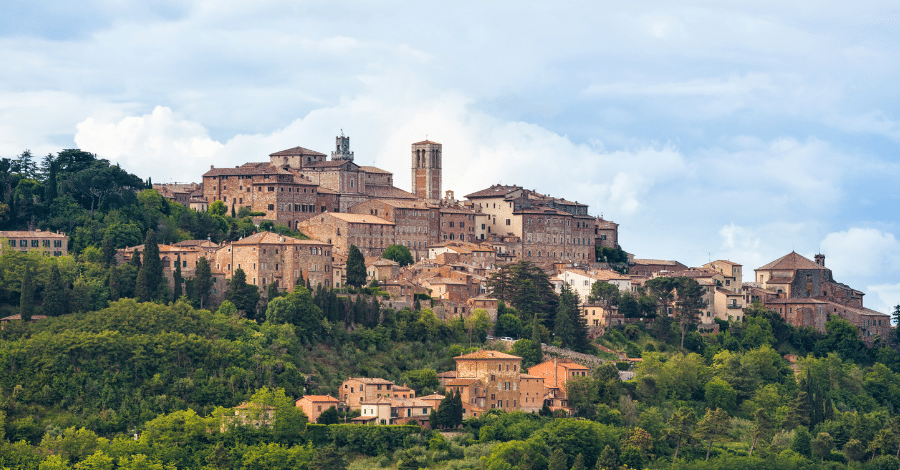Montepulciano, Italy is an emblematic medieval town in the heart of Tuscany, an enchanting oasis of undulating hills and verdant vineyards. It’s renowned for its esteemed Montepulciano wine as well as its venerable town center filled with quaint piazzas, sacrosanct churches, and panoramic viewing terraces overlooking the bucolic countryside below.
This beguiling destination in Italy would make a perfect day excursion or sojourn from which you can discover the countryside gems of Tuscany. Montepulciano, Italy, stands out as one of the most stunning towns in all of Italy, a true picture-perfect beauty.

Where is Montepulciano, Italy?
Montepulciano is a gorgeous hilltop town located in the environs of the province of Siena, in the region of Tuscany. It stands atop an elevated limestone ridge about 8 miles from Pienza and 45 miles southeastwardly from Siena.
Furthermore, Montepulciano is conveniently situated 77 miles away from Florence, 110 miles from Lucca and 115 miles to the north of Rome. The closest major city is Perugia, 40 miles away, which can be reached in about one hour by car.

Montepulciano is home to about 15,000 residents and it is usually buzzing with tourists, as it is a well-known tourism destination. The town may also be reached by bus from the surrounding major cities, and the closest train station is in Chiusi, a few miles away.
What is Montepulciano, Italy famous for?
1. Montepulciano wine
Red wine is what put Montepulciano on the map. This is a wine-producing region, famous for its thick-skinned red grape of the Montepulciano variety. The grapes grown in this area yield three types of dark red wine that have been granted the Denominazione di Origine Controllata (DOC) status, which is an Italian designation for wine and food products that indicates a higher quality standard when compared to other wine and food products.

The DOC is granted to wines such as Vino Nobile di Montepulciano, Rosso di Montepulciano, and Vin Santo de Montepulciano. Winery tours and wine tastings are a favorite activity when visiting this area.
2. Piazza Grande in Montepulciano, Italy
Piazza Vittorio Emanuele, more often referred to as Piazza Grande, is the main plaza in Montepulciano, Italy. It is encompassed by several influential edifices such as the Palazzo Comunale which was constructed in 1424 and fashioned by the Florentine Renaissance designer Michelozzo. The Palazzo Comunale’s development started at the end of the fourteenth century and it has sustained its existing configuration since then.

Palazzo Contucci is another building in the Piazza Grande, and it is a structure constructed during the 16th century by Antonio da Sangallo. It contains many frescoes painted by the famous artist Andrea Pozzo.

Next, we have an expansive edifice known as Tarugi, which features spacious loggia at its street level. Nearby Tarugi, we have an imposing fountain that dates back to 1520. The fountain contains two Etruscan columns and two twin stone lions above it that are adorned with the Medici coat of arms.
3. Duomo in Montepulciano, Italy
Duomo, in Montepulciano Italy, is a cathedral, and it was conceptualized by Ippolito Scalza and erected between the years 1592 and 1630, as a replacement for its predecessor parish church. The frontage of the cathedral boasts unfinished stonework that was supposed to be decorated with something more attractive but ultimately remained incomplete in the end.
Inside the grand entrance of the hallowed cathedral, to its left-hand side, lies a statue from the Early Renaissance times. It is Bartolomeo Aragazzi – Secretary to Pope Martin V – and it was carved by Michelozzo di Bartolommeo. The monument has been dismantled and several components of it can be discovered scattered throughout this edifice.

Inside the cathedral, behind the main altar stands an artwork from the 15th century, a triptych of The Assumption, designed by Taddeo di Bártolo. Additionally, inside the cathedral, we have a painting created by an artist named Sano di Pietro, which is known as the Madonna of the Pillar, which symbolizes Mary tenderly embracing Jesus, with one hand while Jesus grasps a little fowl in another palm.
4. San Biagio in Montepulciano, Italy
San Biagio is a well-known church in Montepulciano, Italy, and it was crafted between 1518 and 1545, under the guidance of Antonio da Sangallo the Elder. This illustrious Renaissance edifice is highly dignified for its golden travertine facade which shelters an ancient venerated representation of the Madonna. Its exquisite excellence makes it one of Italy’s most remarkable testimonies to this epoch in history.
The interior of the church boasts a Greek cross plan, with four arms that are all equal in length and an elevated dome. Two bell towers adorn the facade, with one form, and one half-formed. The presbytery showcases 16th-century frescoes painted by the Zúccari siblings, which feature scenes from Mary’s existence, such as her end of life, ascension into heaven, and her coronation.

The church, with its high altar, boasts an ornate reredos flaunting four venerated saints from that era. Nearby stands a priest’s house, also designed by Sangallo but erected sometime after his death. At the present, it serves as a repository for an exhibition that glorifies San Biagio himself. As the day draws nigh, illumination from the sun casts upon this church transforming it into beguiling shades of gold.
Best things to do in Montepulciano, Italy
1. Museo Cívico in Montepulciano, Italy
Aside from the obvious wine-related activities, Montepulciano is a wealth of culture and art waiting to be discovered. The Museo Cívico is a museum located in the fourteenth-century Palazzo Neri Orselli. It showcases a diversity of antiquities, pictures, and terra-cottas. The museum’s archaeology area contains Etruscan and Roman’s artifacts discovered at Acquaviva di Montepulciano. In addition to that, spectators can gaze upon medieval as well as Renaissance masterpieces along with items created by Andrea della Robbia.

Inside this museum, you can find the Etruscan funerary urns, which serve as an indication not only of the splendor that existed in antiquity but also demonstrate the significance this region held during those times. Additionally, one may find Madonna and Child which was commissioned for Palazzo del Capitano back in 1484, that is featured among other pieces belonging to della Robbia’s collection.
2. Sant’Agostino in Montepulciano, Italy
Sant’Agostino is a church in Montepulciano, Italy. The church’s frontage is a remarkable Renaissance-style architectural production crafted by Michelozzo di Bartolommeo, who was an apprentice of the illustrious sculptor Donatello. This venerable church has stood since 1285 and is thus far and away the oldest extant church in Montepulciano.

The esteemed Italian architect Michelozzo made several substantial transformations to its inside during his renovation works at some point in the late 17th century, most notably eradicating several aisles, plus other components. On display inside this building stands an impressive wooden crucifix which many attributes to Donatello’s authorship.
3. Santa Maria dei Servi in Montepulciano, Italy
Santa Maria dei Servi is a church located in Montepulciano Italy. This church was constructed during the 14th century and displays a Gothic facade. It has an interior that was renovated by Andrea Pozzo at the termination of the 17th century, to assume its contemporary Baroque opulence.

A stunning Sienese school painting from the 14th century is located inside the chapel. In the Madonna della Santoreggia painting panel, a picture of Mary and the infant Jesus is framed by ornamentation that is credited to a pupil of Duccio di Buoninsegna. Another wall painting that belongs to the 1300s also shows Christ on the crucifixion.
4. Palazzo Avignonesi in Montepulciano, Italy
The Palazzo Avignonesi is a palace located in Montepulciano, Italy, that was designed during the 16th century by Giácomo da Vignola. It features a Late Renaissance facade with masonry rustication along its ground floor and windows accented by alternating pediments composed of triangles and curvatures. Standing in front of the palace is an iconic Marzocco – a lion symbolizing Florence’s authority under Medici rule – which was sculpted by Sarrocchi.

The Palazzo Avignonesi is a beautiful example of Renaissance architecture, with its ornate facades and intricately designed interior. Inside the palace are numerous examples of period furniture and artworks which add to the grandeur of this historical building. The iconic Marzocco in front further serves as an emblem of Florence’s power during Medici rule while also acting as a symbol to visitors that they were entering somewhere important when approaching the palace.
Dreaming of escaping to charming Italy? Explore more articles to learn about living in Italy.

